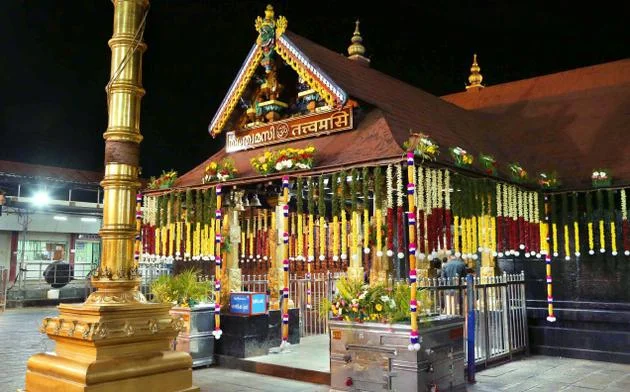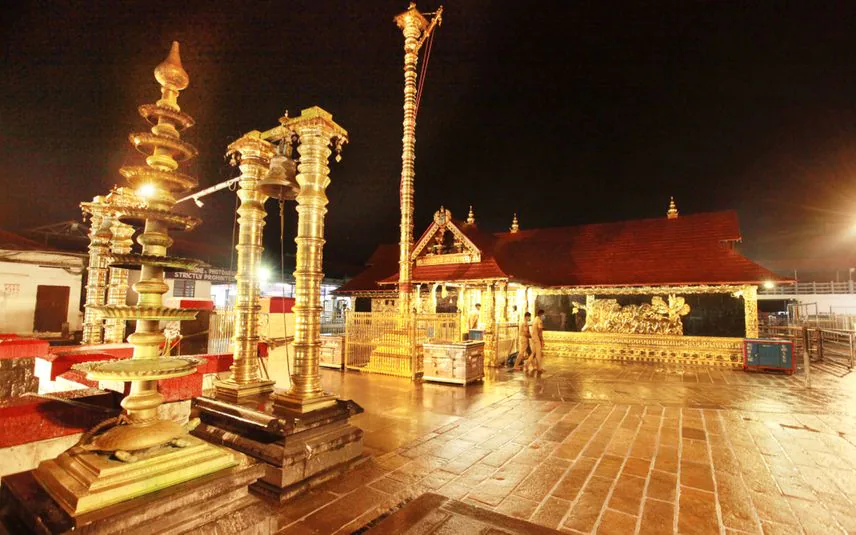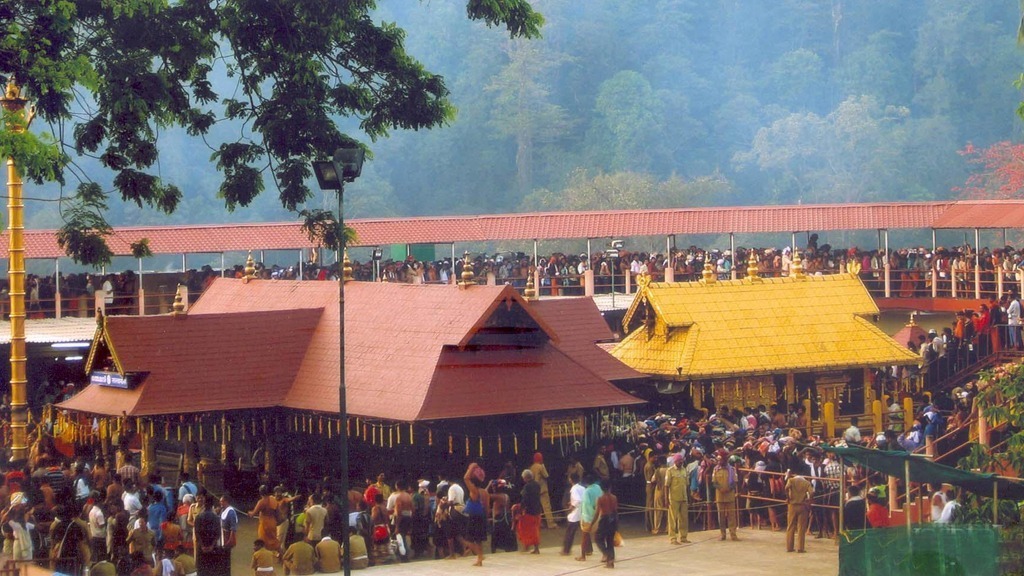
Sabarimala Sastha Temple , Pathanamthitta
Sabarimala is one of the most celebrated temples in South India. It is situated inside the Periyar Tiger Reserve in Pathanamthitta district in Kerala. The temple is dedicated to Lord Ayyappa who, according to lore, is the son of Lord Shiva and Mohini, the feminine incarnation of Lord Vishnu.
The Sabarimala Temple is known for its strict adherence to customs and rituals, including the famous 41-day penance observed by pilgrims before they undertake the journey. Devotees follow a celibate lifestyle, wear traditional attire, and abstain from consuming certain foods during this period. The temple gained widespread attention and underwent legal scrutiny in recent years due to the controversy surrounding the entry of women of menstruating age. The Supreme Court of India, in a landmark judgment in 2018, lifted the age-old ban, allowing women of all ages to enter the temple, sparking debates on religious practices, gender equality, and the balance between tradition and modernity.
Historical background and Architectural splendor
The historical background of Sabarimala is deeply rooted in Hindu mythology and traditions. According to legends, Lord Ayyappa, the presiding deity of Sabarimala, is believed to have meditated at this sacred spot after defeating the demoness Mahishi. The pilgrimage season at Sabarimala, known as the Mandalam season, typically occurs from mid-November to mid-January, attracting millions of devotees from various parts of India. The pilgrimage involves a challenging trek through dense forests, symbolizing the spiritual journey and austerity associated with seeking Lord Ayyappa’s blessings.
Architecturally, Sabarimala is renowned for its awe-inspiring temple dedicated to Lord Ayyappa. The Sabarimala Temple is nestled amidst the lush greenery of the Periyar Tiger Reserve, adding to its natural splendor. The temple architecture showcases the traditional Kerala style, characterized by gopurams (tower-like structures), intricate carvings, and vibrant murals depicting scenes from Hindu mythology. The main sanctum sanctorum houses the sacred idol of Lord Ayyappa, attracting devotees who come to seek his divine blessings. The temple complex also includes various other shrines and facilities for pilgrims, contributing to the overall architectural grandeur of Sabarimala as a significant religious and cultural landmark in South India.

Religious Significance
This place holds immense religious significance in Hinduism, drawing pilgrims from across the country to partake in a spiritually enriching journey. The temple is dedicated to Lord Ayyappa, a revered deity believed to be an embodiment of the combined energies of Lord Shiva and Lord Vishnu. Devotees undertake the pilgrimage to Sabarimala to fulfill vows, seek blessings, and attain spiritual purification. The trek through dense forests and challenging terrain is considered a symbolic representation of the devotee's determination, penance, and detachment from materialistic pursuits. The religious rituals and traditions associated with Sabarimala are deeply ingrained in Hindu customs. Pilgrims adhere to a strict 41-day austerity period, observing celibacy, practicing self-discipline, and abstaining from certain dietary habits. The pilgrimage culminates in the Mandalam season, marked by the Makaravilakku festival when a divine light is believed to appear atop the nearby hill, further enhancing the religious fervor. The unique traditions, sacred rituals, and the divine aura surrounding Sabarimala contribute to its significance as a sacred site, fostering a sense of unity and devotion among millions of Hindu devotees who partake in this annual pilgrimage.

Festival and Celebrations
The festivals and celebrations enhance the cultural and religious significance of Sabarimala, creating a sense of community and devotion among the pilgrims who participate in these events. Some of the festivals celebrated here are Makaravilakku, Mandalam Festival, Vishu and Onam.
Surroundings area & attractions
- Pampa River: The sacred Pampa River flows near the temple, and pilgrims traditionally take a ritual bath in its waters before beginning their trek to Sabarimala.
- Pandalam Palace: Pandalam, located about 14 kilometers from Sabarimala, is associated with the birth of Lord Ayyappa. The Pandalam Palace, the ancestral home of the royal family, is a significant pilgrimage spot.
- Erumeli: A town situated on the way to Sabarimala, Erumeli is known for the Vavar mosque, dedicated to Vavar Swami, a friend of Lord Ayyappa. Pilgrims often stop here during their journey.
- Perinadu Muthalakkal Bhagavathy Temple: Located near Erumeli, this temple is dedicated to Goddess Bhagavathy and is another sacred site visited by devotees during their pilgrimage.
- Nilakkal: Nilakkal is an important base camp for Sabarimala pilgrims, and it serves as a starting point for the trek. The Mahishi demon temple and the Marakkoottom Mahadeva Temple are notable landmarks in Nilakkal.
- Achankovil Sastha Temple: Situated around 80 kilometers from Sabarimala, this ancient temple dedicated to Lord Ayyappa is another pilgrimage site with its own unique traditions.
Visitor information
Entry Fee: Rs.25/-
Timings :
- Morning: 3 am–1 pm
- Evening 3–11 pm
Darshan Days- All days
Address:
Swamy Ayyappan Rd, Sannidhanam, Sabarimala, Kerala 689662
Notable Events and Incidents
- Makaravilakku Tragedy
- Women's Entry Protests
- Sabarimala Pilgrimage Season Floods
- Women's Entry Following Supreme Court Verdict
- Opening of Sabarimala to Non-Hindus
- Fireworks Tragedy
- Installation of the Gold-Plated Mast
Connectivity :
- By Air: The nearest airport to Sabarimala Sastha Temple is the Trivandrum International Airport (Thiruvananthapuram), approximately 170 kilometers away.
- By Land:This plac is well-connected by roads, and pilgrims can reach the base camp at Pampa by private vehicles, taxis, or state-run buses.
- By Bus: State-run and private buses operate regular services to Pampa, the base camp for Sabarimala pilgrimage. Pilgrims can utilize bus services from major cities in Kerala to reach the starting point of their trek to the Sabarimala Sastha Temple.
FAQ
The Sabarimala Temple is located in the Western Ghats mountain ranges of Pathanamthitta district in Kerala, India.
The presiding deity of the Sabarimala Temple is Lord Ayyappa, also known as Dharma Sastha, a revered deity among Hindus.
The Sabarimala Temple is one of the most prominent and sacred pilgrimage destinations in India. It is believed to be the place where Lord Ayyappa meditated after defeating the demoness Mahishi.
The main pilgrimage seasons at the Sabarimala Temple are the Mandala Pooja (November-December) and the Makaravilakku (January), attracting millions of devotees from various parts of the country.
Devotees observe a 41-day Vratham, which includes strict practices such as celibacy, abstinence from non-vegetarian food, alcohol, and tobacco, to purify the body and mind before undertaking the pilgrimage.
The rituals and ceremonies at the Sabarimala Temple include the Neyyabhishekam (ghee offering), Padipooja (worship of the sacred steps), and the Deeparadhana (lamp lighting ceremony), among others.
Yes, male pilgrims (known as Ayyappa devotees or Swamis) are required to wear traditional attire called Irumudi and observe strict celibacy during their pilgrimage. Female devotees between the ages of 10 and 50 are traditionally not allowed to enter the temple.
The Pathinettam Padi represents the 18 steps that lead to the sanctum sanctorum of the Sabarimala Temple. It is believed that these steps symbolize the path to enlightenment and liberation from the cycle of birth and death.
As of recent years, the entry of women of menstruating age (10-50 years) was restricted by tradition and temple customs. However, this practice has been a subject of legal and societal debate, with the Supreme Court of India making rulings regarding the entry of women into the temple.
The Sabarimala Temple provides various facilities for pilgrims, including accommodation, medical facilities, food stalls, and restroom facilities. Additionally, there are designated queues and pathways to ensure smooth movement of devotees during peak pilgrimage seasons.
Pilgrims can reach the Sabarimala Temple by road, rail, or air. The nearest major railway station is located in Kottayam, and the nearest airport is in Kochi. From these points, pilgrims can travel by road to Pamba, the base camp for the Sabarimala pilgrimage, and then trek through the forest to reach the temple.
The Makaravilakku festival is celebrated in January, marking the culmination of the Mandala Pooja pilgrimage season. It is believed that Lord Ayyappa appears as a divine light (Makaravilakku) atop the Ponnambalamedu hill during this festival, symbolizing his divine presence.
Devotees offer various types of prayers and offerings at Sabarimala, including the breaking of coconuts, lighting lamps, and offering ghee (neyyabhishekam) to Lord Ayyappa. Many pilgrims also carry Irumudi, a special bag containing offerings for the deity.
The pilgrimage route to Sabarimala, known as the forest path or the holy trek (nada padayatra), is considered sacred by devotees. It is believed to be the path taken by Lord Ayyappa during his forest dwelling. The trek is seen as a journey of spiritual purification and self-discipline.
The river crossing, known as Aravana Payasam, is an important ritual during the Sabarimala pilgrimage. Devotees traditionally cross the river Pamba before ascending the holy steps of Sabarimala. It symbolizes the crossing of worldly attachments and purification of the soul.
The Vavar Mosque near Sabarimala Temple is dedicated to Vavar, a Muslim saint who is believed to be a close associate of Lord Ayyappa. Devotees of all faiths visit the mosque and seek the blessings of Vavar before proceeding to Sabarimala.
Yes, photography and videography are restricted inside the sanctum sanctorum and certain areas of the Sabarimala Temple.
The Sabarimala Temple administration employs crowd management strategies, including designated queues, security personnel, and crowd control measures, to ensure the safety and orderly movement of pilgrims during peak pilgrimage seasons.
Yes, various plants and trees along the pilgrimage route to Sabarimala are considered sacred and are associated with legends and folklore related to Lord Ayyappa. Devotees often offer prayers and seek blessings from these natural elements during their journey.
The Sabarimala Temple pilgrimage season is a major source of revenue for the local economy, including transportation, accommodation, food vendors, and local businesses. Additionally, the temple administration supports various community development initiatives and charitable activities.
